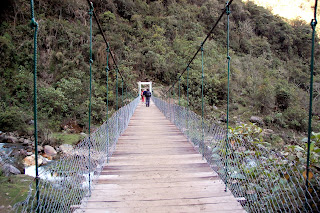"This is all very urgent," we told the laundry woman. "Very sorry, but we need it all back by this evening. And especially really sorry it's all so dirty." When we opened the bag out in the laundrette, there was actually a foul smell of festering mountain dirt that filled the little room. And when I say laundrette, I really mean a woman who was going to wash everything by hand, under the tap.
But as it turned out, she was a hardy old soul, and had probably seen hikers in far worse condition than us. Or at least with laundry in far worse condition than ours.
"No problem, I'll deliver it to your hostal this evening," she said, cheerfully charging us double for the efforts. Best money by far that we ever spent though.
Later that day, we went to Sacsayhuaman, the second-most sacred Incan ruins after Machu Picchu. It was a pretty steep climb up the hill, which would have probably defeated us pre-Salkantay, but this time, strengthened by our experiences, we positively skipped up the hill. The temple of Sacsayhuaman (pronounced 'sexy woman' much to everyone's snickering delight), is built up of some of the hugest rocks found in any Incan ruins still remaining.
The Incans had somehow mined these rocks in quarries miles away, hauled them intact up the mountains, and chiseled them to perfection so they fit tightly against eachother without as much as a centimeter between them. And then managed to buid every temple so that the sun's first rays would enter the windows specifically on the dates of summer and winter solstices (their way of tracking the vernal calendar). As you stand there, gazing at the walls, the immensity of what they accomplished hits you like a ton of bricks (rocks?). I can't believe some of them didn't just say '"forget that, I'm going to start a new religion where the gods live in little pebble houses down on the plains". People cite aliens and magic and cosmic energies and all sorts of ideas typical of when we just can't figure out how they did it, but the Incans were a remarkably scientific people, so those theories are probably making them turn in their graves.
After Cusco, we headed down to the Amazon for a few days, and stayed in a remote lodge on the edge of an oxbow lake in the Amazon basin. To get there, we had to take a 45 minute flight to Puerto Moldonado, a 45 minute boat ride up the river, a 2 hour walk through the jungle, and another 45 minute boatride to the other side of a lake. You get the idea. Once you're there, you're there to stay.
Based on Rohinton and Jeet's experience in the rainforest, I had entered the Amazon with two primary fears:
- that after dark there would be large toads the size of dinner plates that would jump onto our feet if we left the room
- that swarms of mosquitoes would attack my posterior when I lowered my pants to pee, and I would need to get steroid shots in the hiney before I could sit again
But as it turned out (fortunately), neither of those fears transpired. Ultimately, the worst creature we faced was those evil vampire chiggers in the hotsprings. And I say this with deliberate consideration, I haven't forgotten the giant tarantula (bigger than my palm) that lived in the front garden of the lodge. Or the time our guide told us, "there's a dedicated swimming area in the lake, that's safer than the other parts. But only go in at your own risk, it still has piranhas, electric eels and sting rays." Or the time a moth the size of a saucer flew into our room (our strategy would be to put out our lights before everyone else, so the insects would fly elsewhere. Sick, I know. But it's all about self-preservation in the jungle).
We couldn't believe it! The waiter from our restaurant had actually ordered and delivered the plates! We rushed to take a look. Yep, and there they were, four of the most beautiful, hand-painted, wooden plates we could have ever asked for. So that afternoon, apt for our last day in Peru, Delta and I headed over back to the restaurant where we'd had our first dinner, thanked the waiter and paid him the rest of our share of the bargain.
































